I received a free copy of this book from Beacon Press via LibraryThing. I’m grateful to Beacon Press for their generosity and, because I was fascinated by this book, was happy to post this honest review. All opinions are my own.
The recounting of national histories is never separate from present-day politics. What of the past is remembered, celebrated, and mourned is at the core of national identity—and the process of what is told and not told is often a function of power…Racial injustice is America’s original sin and deepest silence. The ways the country came to honor the civil rights movement were not simply about paying tribute to these courageous acts and individuals in the past but also about sanctioning what will—and will not be—faced about the nation’s history and presence….While these tributes honored the movement, they simultaneously depoliticized the scope of the struggle, distorted the work of the activists honored, demonized Black anger, and obscured ongoing calls for racial justice through a celebration of a nearly postracial, self-correcting America.
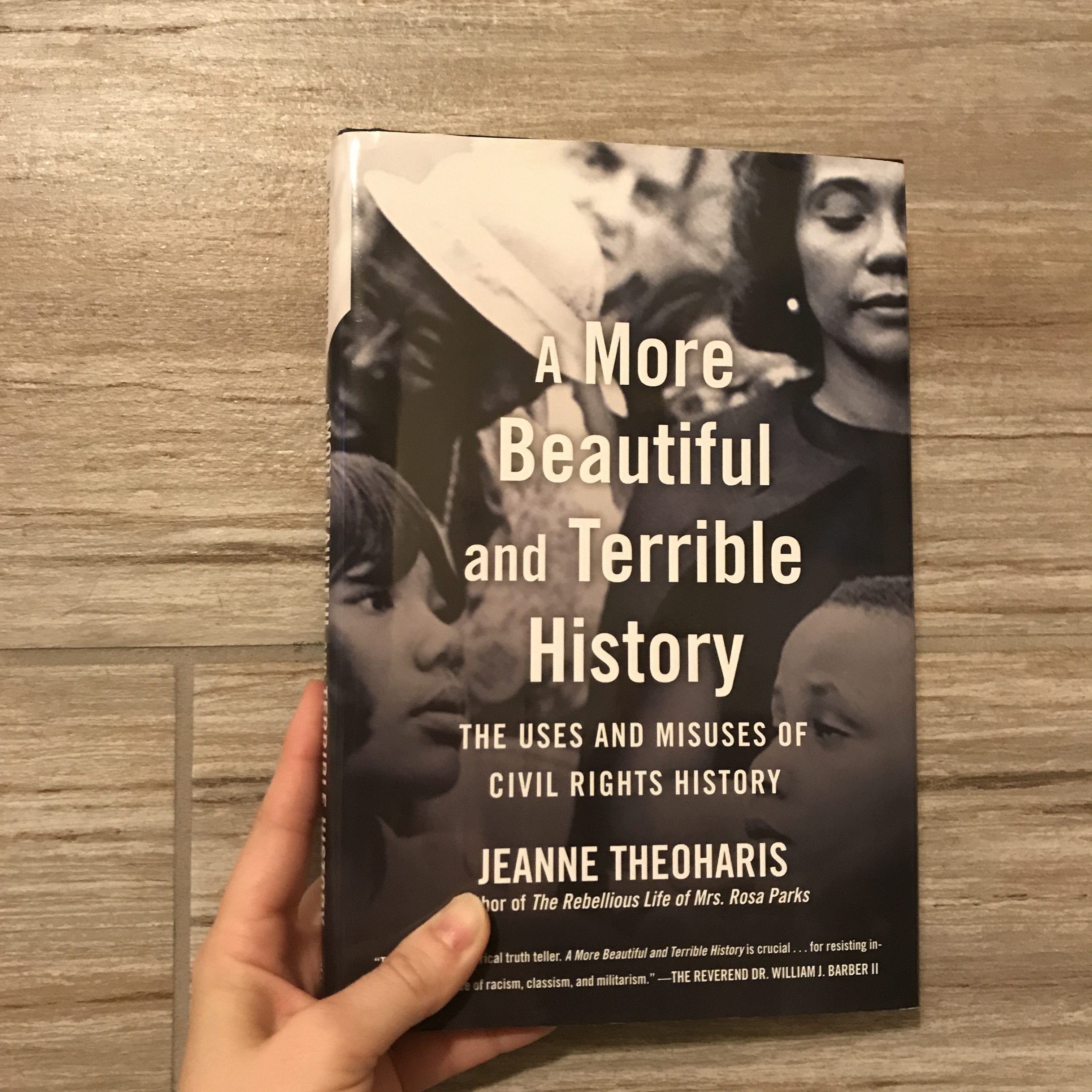
Synopsis
In A More Beautiful and Terrible History, Professor Jeanne Theoharis examines the myths of the Civil Rights Movement and contrasts these
myths with the real history, the forgotten youths and women and the ignored cities in the North and West that featured prominently in the actual movement. While I was not terribly surprised by what Theoharis presented as the unvarnished history of the Civil Rights Movement (of course women were involved. of course segregation was occurring in the North), the history presented in this book is a sharp contrast to what I learned every February (and only in February) from grade school through high school. While memory fades over time and its been over twenty years since elementary and middle school, I will go so far as to say I think I learned more from this book than I ever learned in my history classes growing up.
In many ways, A More Beautiful and Terrible History reminded me of Lies My Teacher Told Me by James W. Loewen. Theoharis goes one step further than Loewen (or than I remember Loewen going) and explains why these myths are so useful to those interested in maintaining the status quo. She demonstrates how these myths are weaponized against the current movement to delegitimize Black Lives Matter, #NoDAPL, and others. These connections were the icing on the cake for me in this book—it is not enough to acknowledge that we have made history convenient in our retelling but to see why these myths were created, how they were useful then, and how they are being used now made Theoharis’s work an urgent, timely read.
Credentials
I will admit that one of the first things I did upon receiving this book was flip to the author’s picture. I was surprised to see that Theoharis is white. Her author’s note reveals that Theoharis’s family escaped the Armenian genocide that the United States still refuses to acknowledge. As she notes, “[g]rowing up Greek-Armenian in my politically active family made the importance of the histories we tell and those we deny potent and visceral.” With this foundation, Theoharis has published or co-published numerous works on African-American history, including an NAACP award-winning biography on Rosa Parks. (Unfortunately for me, this means that Rosa Parks isn’t addressed as deeply in A More Beautiful and Terrible History as I would have liked because Theoharis didn’t want to repeat herself. The only logical result of this is that The Rebellious Life of Mrs. Rosa Parks was added to my TBR.)
A Readable Academic Work
A More Beautiful and Terrible History is a bit more of an academic book than I typically pick up for a non-fiction read. I tend to stick to more narrative non-fiction—having been a history major in college, I’d prefer my history now come in story form, please and thank you. And yet, when LibraryThing posted this book as a giveaway, I found myself drawn to it. Theoharis’s work is an academic work that I can see a professor assigning in American history or historiography classes. Her work is thoroughly researched and her sources are well-cited (the last thirty-plus pages are notes). The writing, while clear and concise, is not a narrative. And yet, with the minor caveat that it dragged a bit in the middle (as noted below), I found A More Beautiful and Terrible History to be surprisingly readable for a popular audience.
The depth of her writing made me take this book one chapter at a time—I only picked it up when I had the attention span to really dig into a chapter and sit with what she was saying. If I was tired or limited for time, I picked up something else. I recommend this as the way to read A More Beautiful and Terrible History. This isn’t a narrative to fly through, nor is it a book that deserves to be skimmed.
Organization
The book is organized thematically, with chapters examining the forgotten Jim Crow North, the long struggle that preceded the successes (i.e., the Montgomery Bus Boycott didn’t happen in a vacuum, nor was Rosa Parks an accidental activist), the racism of the “White Moderate,” the media’s bias against the movement, the placement of the Civil Rights Movement within the larger global anti-poverty and anti-war movements, the young people who pushed the movement forward, the women who led, and the active demonization of the movement by the government. Overall I liked this organization—I highlighted my copy on almost every page and this thematic structure will make it easier to find things later or revisit specific chapters. The only downside to this meant that certain examples were used repeatedly and, at times, started to feel repetitive. The fight to desegregate schools in New York, for example, appeared in chapters on the Jim Crow north, the long struggle, the media bias, and the importance of students to the movement. While a different point was made each time this example was raised, it did start to make the book drag a bit. I’m not sure there is a solution to this since a purely chronological presentation would have been difficult to follow and these large-scale but forgotten events were the perfect examples for the points Theoharis was making. If you decide to pick this one up and similarly feel the book dragging a bit, know that after chapter six (young people), these examples are replaced by new ones and the last third of the book picks back up.
Exceptionalism & Austin, Texas
As an Austinite, it is easy to believe we live in an exceptional city—we are the blue dot in the red sea. If we are exceptional then, the things that apply to everywhere else—racism, sexism, and homophobia—do not happen here. We are enlightened. We are different. We keep Austin weird.
And yet, several months ago, when there was a bomber leaving packages around the city, the first bomb barely made the news. The second bomb didn’t make national news until there was a third. The first bomb killed an African American man. The second an African-American teenager—a teenager whose talent and exceptionalism is highlighted every time he is mentioned. It is a grave loss to our community and to music that Draylen’s life was cut short. But this would be true even if Draylen had not been a rare talent at the bass but simply a C student who loved to play pick-up basketball. The city wasn’t really brought to its knees in fear until a bomb went off in an affluent, mostly white neighborhood. Austin’s greatest sin is that it believes it is exceptional while being just as racist as much of the rest of the country.
I have a friend who moved from Austin several years ago because, among other reasons, it just became too hard to be black here. To have her child be the only black child in his class. To be attacked in the carpool line by a angry Lululemon-wearing mom because her talk at Blogher about America not being here for people of color went viral. To know that if she called the police from that carpool line, it was likely Lulu-Mom who was going to be believed.
Conclusion
In many ways, Austin is a microcosm of what Theoharis presents in A More Beautiful and Terrible History. We have, as Austinites and as Americans, bought into the lie of our exceptionalism. We believe that this history was inevitable because America will always do what is right. We are self-correcting and needed only the nonviolent encouragement of Martin Luther King Jr. to correct what was an exclusively Southern problem.
As members of BlackLivesMatter and others calling for racial justice as demonized daily in the news, it is more vital than ever that we read works like this to see where we came from, what really happened, and the ways those in power and in the media use the lie of our exceptionalism to maintain a white status quo.
Notes
Published: January 30, 2018 by Beacon Press (@beaconpress)
Author: Jeanne Theoharis
Date read: May 26, 2018
Rating: 4 ½ stars

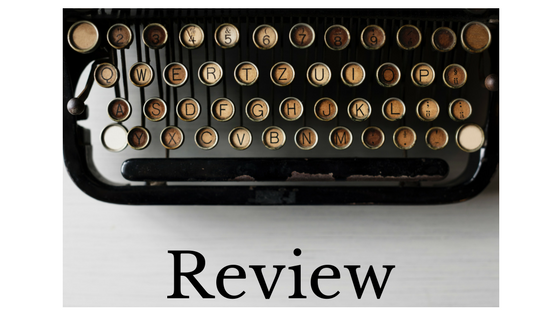
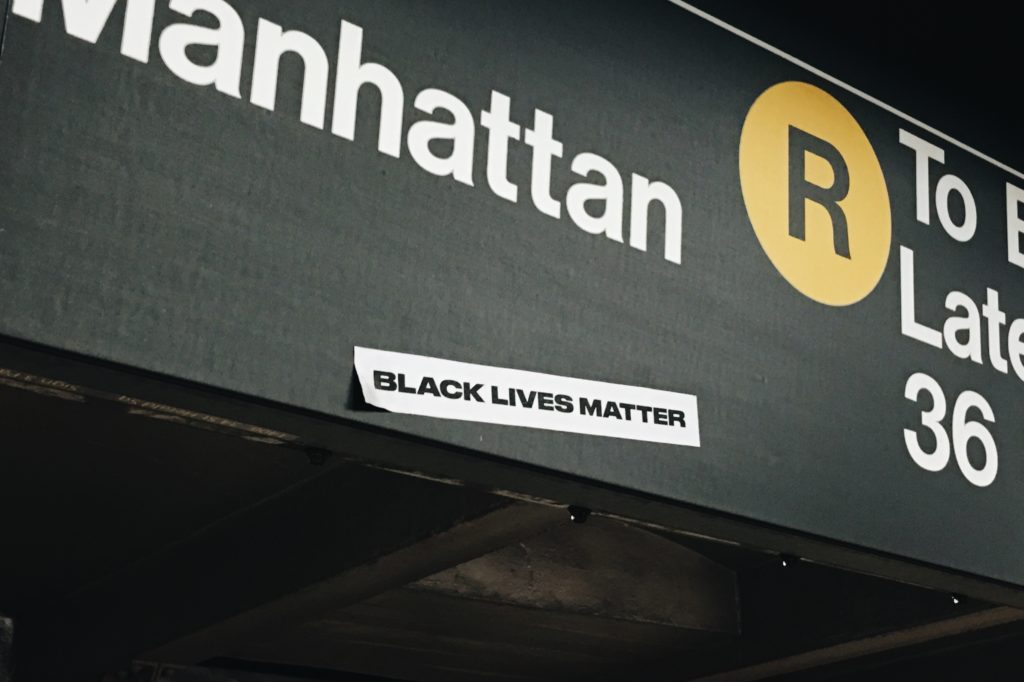
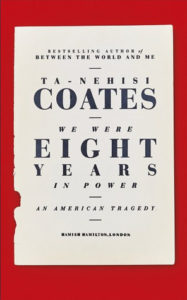 Coates’s most recent offering is a compilation of the essays he wrote for The Atlantic during the eight years of Obama’s presidency, one per year, with commentary of what was going on in his life and the life of many black Americans during each of the eight years. Because the essays were originally magazine articles, there is some repetition among them of certain points or common phrases that, if this were a book of essays, would likely have been edited to fit better. None of the thoughts or arguments that were repeated were long, so the repetition didn’t bother me as a reader, nor did it cause me to go into skim mode. It was just noticeable. The introductions to each article were interesting in that, while the context was helpful, Coates also comments on the following article—things he wished he had done differently, whether some of his points or predictions held up, and general criticism of his work. As a reader, this was a strange device and it made me wish that the “intro” essays followed the pieces instead. His critique of his own work colored how I read the article and I wished before some of them that I had a chance to form my opinion before reading his hindsight-critique.
Coates’s most recent offering is a compilation of the essays he wrote for The Atlantic during the eight years of Obama’s presidency, one per year, with commentary of what was going on in his life and the life of many black Americans during each of the eight years. Because the essays were originally magazine articles, there is some repetition among them of certain points or common phrases that, if this were a book of essays, would likely have been edited to fit better. None of the thoughts or arguments that were repeated were long, so the repetition didn’t bother me as a reader, nor did it cause me to go into skim mode. It was just noticeable. The introductions to each article were interesting in that, while the context was helpful, Coates also comments on the following article—things he wished he had done differently, whether some of his points or predictions held up, and general criticism of his work. As a reader, this was a strange device and it made me wish that the “intro” essays followed the pieces instead. His critique of his own work colored how I read the article and I wished before some of them that I had a chance to form my opinion before reading his hindsight-critique.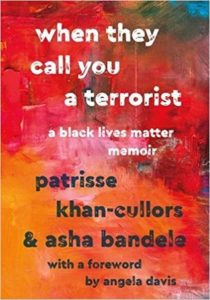 The focus of probably the first half of When They Call You a Terrorist was not what I expected since Khan-Cullors’s recollections seemed more about her brother’s experience with an inadequate public and prison mental health system than it did on her brother’s blackness. Which is not to say that his blackness was ignored or even that his blackness didn’t greatly affect the way the mental health and law enforcement systems responded to him. I simply didn’t know much about Khan-Cullors before listening (I think literally the only thing I could recall hearing about was her partner’s being detained trying to come into the country from Canada) and so did not expect the lengthy discussion of mental illness. Her compassion for her brother and the way the family tried to treat him and have others treat him with as little force as possible made me hurt for her. (Khan-Cullors reads the book herself, which added to the tragedy inherent in many of the sections.) Because so much of the first half of the book is simultaneously a study of being black and having a mental illness, I would go so far as to say that if you’re interested in hearing about the lived experience of trying to obtain mental health care in a broken system, this is a powerful book for that alone.
The focus of probably the first half of When They Call You a Terrorist was not what I expected since Khan-Cullors’s recollections seemed more about her brother’s experience with an inadequate public and prison mental health system than it did on her brother’s blackness. Which is not to say that his blackness was ignored or even that his blackness didn’t greatly affect the way the mental health and law enforcement systems responded to him. I simply didn’t know much about Khan-Cullors before listening (I think literally the only thing I could recall hearing about was her partner’s being detained trying to come into the country from Canada) and so did not expect the lengthy discussion of mental illness. Her compassion for her brother and the way the family tried to treat him and have others treat him with as little force as possible made me hurt for her. (Khan-Cullors reads the book herself, which added to the tragedy inherent in many of the sections.) Because so much of the first half of the book is simultaneously a study of being black and having a mental illness, I would go so far as to say that if you’re interested in hearing about the lived experience of trying to obtain mental health care in a broken system, this is a powerful book for that alone.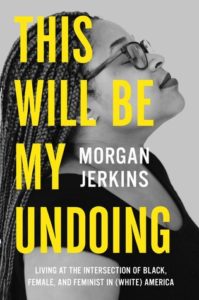 Admittedly, of the three books featured here, this one probably made me the most uncomfortable, but mostly because I don’t read very many books that prominently feature essays about labia and vibrators. Which, let me quickly add, were not mentioned for shock value—this wasn’t a book that I felt like I wanted to put down because it veered into the gross-Lena-Dunham-esque territory. There were just a few moments of “oh—I don’t know that I’d talk about that publicly but here we go.” I will say, this book probably made me the most uncomfortable of the three, though it was an uncomfortable that, like
Admittedly, of the three books featured here, this one probably made me the most uncomfortable, but mostly because I don’t read very many books that prominently feature essays about labia and vibrators. Which, let me quickly add, were not mentioned for shock value—this wasn’t a book that I felt like I wanted to put down because it veered into the gross-Lena-Dunham-esque territory. There were just a few moments of “oh—I don’t know that I’d talk about that publicly but here we go.” I will say, this book probably made me the most uncomfortable of the three, though it was an uncomfortable that, like 



